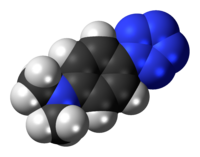4-dimetilaminofenilpentazol
| 4-dimetilaminofenilpentazol Alerta sobre risco à saúde | |
|---|---|

| |

| |
| Nome IUPAC | 4-dimetilaminofenilpentazol |
| Identificadores | |
| Número CAS | |
| PubChem | |
| ChemSpider | |
| SMILES |
|
| Propriedades | |
| Fórmula molecular | C8H10N6 |
| Massa molar | 190.205 |
| Página de dados suplementares | |
| Estrutura e propriedades | n, εr, etc. |
| Dados termodinâmicos | Phase behaviour Solid, liquid, gas |
| Dados espectrais | UV, IV, RMN, EM |
| Exceto onde denotado, os dados referem-se a materiais sob condições normais de temperatura e pressão Referências e avisos gerais sobre esta caixa. Alerta sobre risco à saúde. | |
O 4-dimetilaminofenilpentazol é um composto instável e explosivo que contém um raro anel pentazol, formado por cinco átomos de nitrogênio. O efeito doador de densidade eletrônica do substituinte 4-dimetilamino no anel fenil confere a esse composto uma das maiores estabilidades dentre os fenilpentazois. À temperatura ambiente, sua meia-vida é de apenas algumas horas, mas é possível estocar a substância a baixas temperaturas.
O composto foi sintetizado pela primeira vez em 1956,[1][2][3] junto de outros fenilpentazois substituídos. Estudos foram conduzidos com vários outros derivados, apesar de bastante restritos em função da instabilidade desses compostos.[4][5][6][7][8] Alguns derivados mais substituídos, como o 2,6-di-hidroxi-4-dimetilaminopenilpentazol, são um pouco mais estáveis, mas sua síntese é mais complicada.[9][10]
Pesquisas recentes têm focado esforços na formação de complexos de metais de transição desses derivados do pentazol, já que o anel presente deve ser estabilizado por meio de ligações a um centro de coordenação metálico.[11][12][13]
Referências
- ↑ Ugi I, Perlinger H, Perlinger L. Pentazole III. Kristallisierte Aryl-pentazole. Chemische Berichte 1958; 98:2324-2329,
- ↑ Huisgen R, I. Ugi. Zur Losung eines klassichen Problems der organischen Stickstoff-Chemie. Angewandte Chemie. 1956; 68:705-706.
- ↑ Ugi I, R. Huisgen. Pentazole II. Die Zerfallsgeschwindigkeit der Arylpentazole. Chemische Berichte. 1958; 91:531-537.
- ↑ Carlqvist, P. (2004). «The Stability of Arylpentazoles». The Journal of Physical Chemistry A. 108 (36). 7463 páginas. doi:10.1021/jp0484480
- ↑ Radziszewski JG, Benin V, Kaszynski P, Radziszewski JG (Fevereiro de 2002). «Arylpentazoles revisited: experimental and theoretical studies of 4-hydroxyphenylpentazole and 4-oxophenylpentazole anion». The Journal of Organic Chemistry. 67 (4): 1354-8. PMID 11846686. doi:10.1021/jo0110754
- ↑ Butler, R. N.; Fox, A.; Collier, S.; Burke, L. A. (1998). «Pentazole chemistry: the mechanism of the reaction of aryldiazonium chlorides with azide ion at −80 °C: concerted versus stepwise formation of arylpentazoles, detection of a pentazene intermediate, a combined 1H and 15N NMR experimental and ab initio theoretical study». Journal of the Chemical Society, Perkin Transactions 2 (10). 2243 páginas. doi:10.1039/A804040K
- ↑ Butler, R. N.; Collier, S.; Fleming, A. F. M. (1996). «Pentazoles: proton and carbon-13 NMR spectra of some 1-arylpentazoles: kinetics and mechanism of degradation of the arylpentazole system». Journal of the Chemical Society, Perkin Transactions 2 (5). 801 páginas. doi:10.1039/P29960000801
- ↑ John D. Wallis and Jack D. Dunitz. An all-nitrogen aromatic ring system: structural study of 4-dimethyl-aminophenylpentazole. Journal of the Chemical Society. Chemical Communications. 1983: 910-911.
- ↑ Efforts to synthesize the pentazolate anion[ligação inativa]
- ↑ David Adam. The synthesis and characterisation of halogen and nitro phenyl azide derivatives as highly energetic materials. PhD dissertation, Ludwig-Maximilans-Universität München, 2001 [1]
- ↑ Burke, L. A.; Fazen, P. J. (2009). «Correlation analysis of the interconversion and nitrogen loss reactions of aryl pentazenes and pentazoles derived from aryl diazonium and azide ions». International Journal of Quantum Chemistry. 109 (15). 3613 páginas. Bibcode:2009IJQC..109.3613B. doi:10.1002/qua.22408
- ↑ Burke, L. A.; Fazen, P. J. (2004). «Electronic Supplementary Information for Chemical Communications». Chemical Communications (9). 1082 páginas. doi:10.1039/B315812H
- ↑ Tsipis AC,, Chaviara AT (Fevereiro de 2004). «Structure, energetics, and bonding of first row transition metal pentazolato complexes: a DFT study». Inorganic Chemistry. 43 (4): 1273–86. PMID 14966962. doi:10.1021/ic035112g